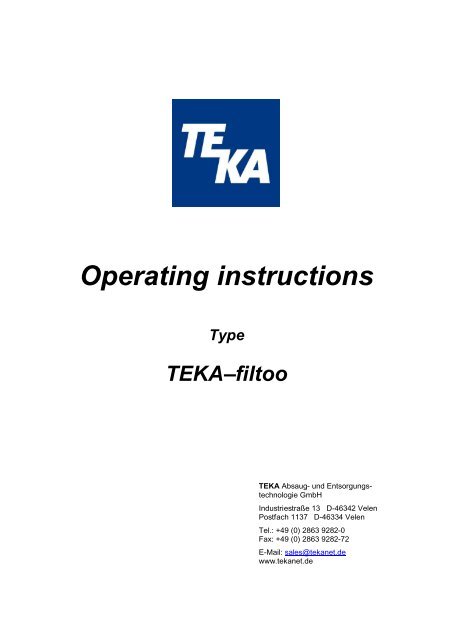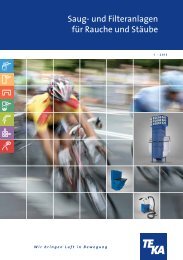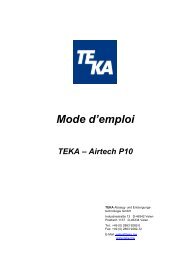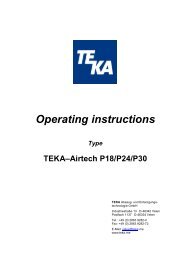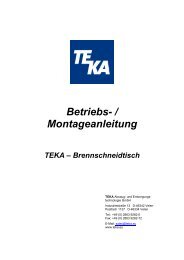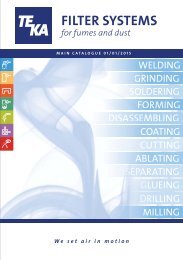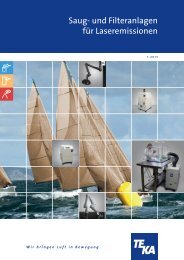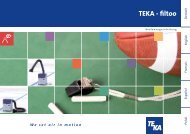Operating instructions - TEKA GmbH
Operating instructions - TEKA GmbH
Operating instructions - TEKA GmbH
Create successful ePaper yourself
Turn your PDF publications into a flip-book with our unique Google optimized e-Paper software.
<strong>Operating</strong> <strong>instructions</strong><br />
Type<br />
<strong>TEKA</strong>–filtoo<br />
<strong>TEKA</strong> Absaug- und Entsorgungstechnologie<br />
<strong>GmbH</strong><br />
Industriestraße 13 D-46342 Velen<br />
Postfach 1137 D-46334 Velen<br />
Tel.: +49 (0) 2863 9282-0<br />
Fax: +49 (0) 2863 9282-72<br />
E-Mail: sales@tekanet.de<br />
www.tekanet.de
Table of contents<br />
1 Description of the elements ................................................................................................................... 3<br />
2 Preface ................................................................................................................................................. 4<br />
3 Conventional application of <strong>TEKA</strong> - filtoo............................................................................................... 5<br />
4 Safety <strong>instructions</strong>................................................................................................................................. 5<br />
5 Commissioning ..................................................................................................................................... 7<br />
5.1 Connecting the extraction elements............................................................................................... 7<br />
5.2 Connecting the device................................................................................................................... 8<br />
6 Explanation of the control elements....................................................................................................... 8<br />
7 Maintenance ......................................................................................................................................... 8<br />
7.1 Replacing the gross filter ............................................................................................................... 9<br />
7.2 Replacing the prefilter.................................................................................................................. 10<br />
7.3 Replacing the activated carbon filter ............................................................................................ 10<br />
7.4 Replacing the main filter .............................................................................................................. 11<br />
7.5 Recommended changing intervals of the filter elements............................................................... 11<br />
8 Disassembly / disposal ........................................................................................................................ 12<br />
9 Detection of faults and malfunctions .................................................................................................... 12<br />
10 Technical data..................................................................................................................................... 13<br />
11 Spare parts list .................................................................................................................................... 14<br />
12 Declaration of conformity for <strong>TEKA</strong> – filtoo........................................................................................... 15<br />
BA_filtoo_100526_GB.doc 2 26.05.2010
1 Description of the elements<br />
Pos.1<br />
Pos.2<br />
Pos.3<br />
Pos.4<br />
Pos.5<br />
Pos.6<br />
Pos.7<br />
Pos.8<br />
Pos.9<br />
Pos.10<br />
Pos.11<br />
Main switch ON / OFF<br />
<strong>Operating</strong> hours meter<br />
Alarm horn signalling a necessary filter<br />
change<br />
Connection for suction arm<br />
Housing<br />
Maintenance flap<br />
Snap fastener for maintenance flap<br />
Retainer<br />
Connection for suction hose (delivery<br />
including covering plate)<br />
Gross filter (placed onto prefilter)<br />
Prefilter (placed onto activated carbon<br />
filter)<br />
Pos.12<br />
Pos.13<br />
Pos.14<br />
Pos.15<br />
Pos.16<br />
Pos.17<br />
Pos.18<br />
Pos.19<br />
Pos.20<br />
Activated carbon filter (placed onto the<br />
main filter)<br />
Main filter<br />
Mains cable including mains plug<br />
Swivel castor with brake<br />
Swivel castor<br />
Screw for assembly of the suction arm<br />
(part provided, not in the picture)<br />
Lock washer for assembly of the suction<br />
arm (part provided, not in the picture)<br />
Rotary flange (part provided, not in the<br />
picture)<br />
Outlet of the cleaned air<br />
BA_filtoo_100526_GB.doc 3 26.05.2010
2 Preface<br />
During the last years, extraction units have become more and more important, especially the filtration of<br />
extracted pollutants and the return of the filtered air into the working space.<br />
This certainly shows that the environmental awareness of the individual has strongly developed in a<br />
positive way since the fact that production (e.g. welding) generates pollutants is undoubted for a long<br />
time. The types of pollutants however depend on the applied procedure. Generally, you distinguish<br />
gases from fumes. Fumes are also known as dusts. If you examine these dusts with a microscope, you<br />
will state that they consist of tiny respirable particles of 0,001 mm or even smaller sizes.<br />
The conventional attempt to improve working conditions at polluted work places is general ventilation.<br />
This procedure is based on a multiple exchange of the air in the production hall, in other words the<br />
complete air is renewed. Nevertheless, this method only reduces the concentration of pollutants in the<br />
respiration zone of the user to a minimal extent.<br />
This also applies for the so-called overhead extraction, i.e. the installation of huge extraction hoods<br />
above the work places. With this badly realized airflow, the pollutants pass by the breathing zone of the<br />
user before they rise up and are captured and taken in. This certainly is not the intended effect. More<br />
efficient than room exhausting or overhead extraction is the elimination of pollutants directly where they<br />
are generated in using local extraction. The investments as well as the operating expenses are much<br />
lower in case of local extraction.<br />
The successful application of this technology implies the technological optimisation of the working<br />
procedure as well as especially the respect of measures with regard to environmental protection and<br />
occupational safety. In the context of a growing sensitization and stricter legal regulations, potential<br />
hazards for the environment and the work place have to be determined prematurely and minimized if<br />
necessary.<br />
BA_filtoo_100526_GB.doc 4 26.05.2010
3 Conventional application of <strong>TEKA</strong> - filtoo<br />
The filter unit filtoo is mainly used for the local extraction of dusts and fumes. To this end, the unit can<br />
be equipped with a flexible suction arm or another extraction device suitable for the individual<br />
application.<br />
The filter unit is adapted for the extraction and separation of welding fumes according to the welding<br />
fume class „W3“<br />
Prohibition of application:<br />
Welding fumes containing oil, aluminium dust, explosive dusts and gases and hybrid mixtures, water,<br />
etc.<br />
(In case of doubt, please contact the manufacturer!)<br />
The polluted air is taken in by the suction hood and enters into the filter unit in passing by the suction<br />
arm or the suction hose. In the filter unit, the gross dust particles are separated in the gross filter (pos.<br />
10), while the finer dusts are separated in the prefilter (pos. 11). The activated carbon filter (pos. 12)<br />
absorbs disturbing odours. The consecutive main filter (pos. 13) separates the fine dust particles with a<br />
separation efficiency of more than 99%. The cleaned air is taken in by the fan and returned to the<br />
working space via the outlet grid at the back of the unit.<br />
Attention:<br />
As soon as the resistance of the filter, due to the separated dust particles and smoke, has achieved a<br />
maximum value, the integrated monitoring electronics triggers off the alarm of the signal horn (pos. 3)<br />
indicating that the filters must be renewed.<br />
(see chapter 7.1: „Replacing the gross filter“, chapter 7.2 „Replacing the prefilter“, chapter 7.3:<br />
„Replacing the activated carbon filter“, chapter 7.4: “Replacing the main filter“)<br />
4 Safety <strong>instructions</strong><br />
When handling electrical appliances, the following general safety measures must be taken for the<br />
protection against electric shocks, risk of injury and fire:<br />
• Read and observe these <strong>instructions</strong> before using the device!<br />
• Keep this operating and maintenance manual in a safe place!<br />
• Do not use the device to extract easily inflammable or explosive gases!<br />
• Do not use the device in explosive zones, e.g. zone 1, zone 2, zone 20, zone 21, zone 22!<br />
• Do not use the device to extract burning or glowing materials, e.g. cigarettes, matches, metallic<br />
dusts, as well as splinters, paper, cleaning cloths etc.!<br />
• Do not use the device to extract burning or inflammable materials, e.g. oil or oil mist, greases,<br />
release agents (e.g. silicone spray), cleaning agents, etc.!<br />
• Do not use the device to extract aggressive media!<br />
• Do not use the device to extract liquids of all kinds!<br />
• Do not use the device to extract organic materials without a written authorization of the<br />
manufacturer!<br />
BA_filtoo_100526_GB.doc 5 26.05.2010
• Protect the connecting plug from heat, humidity, oil and sharp edges!<br />
• Observe the approved supply voltage! (Observe the indications on the nameplate!)<br />
• Only use <strong>TEKA</strong> spare parts!<br />
• Do not use the device without filter elements!<br />
• Before opening the device, separate it from the mains supply!<br />
• The outlet holes must not be covered or blocked!<br />
• Always take care that the device is in a safe position and that the brakes at the swivel castors<br />
are pulled!<br />
• When cleaning and maintaining the device, replacing parts or when changing to another<br />
function, disconnect the filter unit from the mains supply!<br />
• The filter elements must not be reused!<br />
• Dispose of the filter cartridges according to the legal regulations!<br />
• The device must not be used if the mains cable is not in perfect condition!<br />
• The suction hood must be followed the progression of the weld seam, if possible in exploiting<br />
the thermal movements of the welding fume.<br />
• The maximum admissible distance between the extraction element and the welding point should<br />
not exceed 25 cm.<br />
• Do not use the filter unit if one or more parts of the unit are faulty, missing or damaged. In every<br />
of these cases, please contact the <strong>TEKA</strong> service department at the phone number +49 28 63 92<br />
82 0.<br />
• When extracting carcinogenic fumes, e.g. materials containing nickel or chrome, the ventilation<br />
requirements have to be observed!<br />
BA_filtoo_100526_GB.doc 6 26.05.2010
5 Commissioning<br />
The filter unit is delivered completely assembled. The extraction element (suction arm or suction hose)<br />
is separately packed. The extraction element must be connected to the device before commissioning.<br />
5.1 Connecting the extraction elements<br />
If you use a suction arm, fix it with the help of the flange ring (pos. 19), the screws (pos. 17) and the lock<br />
washers (pos. 18) to the upper connection of the housing.<br />
Attention:<br />
Take care that the flange must be pivotal!<br />
If you use the suction hose instead of the suction arm, connect it to the lateral connection opening (pos.<br />
9). In this case, the covering plate fixed to this opening must be fixed to the upper intake opening in<br />
order to close it.<br />
BA_filtoo_100526_GB.doc 7 26.05.2010
5.2 Connecting the device<br />
• Connect the filter unit to the mains supply.<br />
(Observe the indications on the name plate!)<br />
Attention:<br />
Only electricians are authorized to carry out tasks in the electrical field.<br />
Observe the indications on the name plate!<br />
6 Explanation of the control elements<br />
Pos.1 The main switch switches the filter unit on or off.<br />
Pos.2 The operating hours meter counts the operating hours as soon as the main switch is pushed.<br />
Pos.3 The signal horn indicates if the suction performance is sufficient. If it is triggered off, the filters<br />
must be replaced.<br />
7 Maintenance<br />
The filtration of the dust particles increases the saturation degree of the filter cartridge and reduces the<br />
extraction performance.<br />
The saturation degree of the filter cartridge is monitored electronically. In order to maintain the<br />
extraction performance of the device, the filters must be replaced if the signal horn (pos.3) is triggered<br />
off. (see chapter 7.1 “Replacing the gross filter”, chapter 7.2 “Replacing the prefilter”, “chapter 7.3<br />
“Replacing the activated carbon filter”, chapter 7.4 “Replacing the main filter”)<br />
The mechanical filter element makes sure that more than 99 % of the extracted pollutants remain in the<br />
filter. This also applies if the filter element is completely or partly saturated. Nevertheless, the increasing<br />
saturation of the filer reduces the extraction performance of the filter unit.<br />
Gross filter, prefilter and activated carbon filter must be replaced regularly. However, they should be<br />
renewed at the latest when replacing the main filter.<br />
The lifetime of the filter elements heavily depends on the individual conditions of application. Therefore,<br />
it cannot be defined in advance.<br />
Attention:<br />
The operation of the filter device must be interrupted when the filters are replaced.<br />
Only replace and dispose of the filters in sufficiently ventilated area and in wearing an appropriate<br />
respirator mask!<br />
We recommend a respiration half mask according to DIN EN 141/143 protection level P3.<br />
Dispose of the filter according to the legal regulations!<br />
If the filter is beaten, washed or blown out manually, the filter medium may be destroyed. The pollutants<br />
penetrate the ambient air.<br />
BA_filtoo_100526_GB.doc 8 26.05.2010
The correct fitting of the filter elements corresponds to the following order:<br />
Pos.10: gross filter<br />
Pos.11: prefilter<br />
Pos.12: activated carbon filter<br />
Pos.13: main filter<br />
7.1 Replacing the gross filter<br />
• Disconnect the filter unit from the mains supply.<br />
• Release the snap fastener (pos.7) land open the maintenance flap.<br />
• Withdraw the gross filter that is inserted in the main filter. Lift up and pull forward the main filter if<br />
necessary.<br />
• Insert the new gross filter.<br />
Attention:<br />
Only use filter elements by <strong>TEKA</strong>!<br />
• Put the main filter back into the device and position it correctly.<br />
• Fold down the maintenance flap (pos.6) carefully. When doing this,<br />
make sure that the retainer (pos. 8) is placed exactly on the wood frame<br />
of the main filter (pos. 13) and that it moves to the back into the filter unit<br />
if the maintenance flap is closed further.<br />
• When the maintenance flap is completely closed, close it with the help of<br />
the snap fastener.<br />
• Reconnect the filter unit to the mains supply.<br />
BA_filtoo_100526_GB.doc 9 26.05.2010
7.2 Replacing the prefilter<br />
• Disconnect the filter unit from the mains supply.<br />
• Release the snap fastener (pos. 7) and open the maintenance flap (pos. 6).<br />
• Replace the old prefilter with the new one. To this end, lift up and take out the main filter if<br />
necessary.<br />
Attention:<br />
Only use filter elements by <strong>TEKA</strong>!<br />
• Put the main filter back into the unit and position it correctly.<br />
• Fold down the maintenance flap (pos.6) carefully. When doing this, make sure that the retainer<br />
(pos. 8) is placed exactly on the wood frame of the main filter (pos. 13) and that it moves to the<br />
back into the filter unit if the maintenance flap is closed further. See also the overview below at<br />
the section „Replacing the gross filter“.<br />
• When the maintenance flap is completely closed, close it with the help of the snap fastener.<br />
• Reconnect the filter unit to the mains supply.<br />
7.3 Replacing the activated carbon filter<br />
• Disconnect the filter unit from the mains supply.<br />
• Release the snap fastener (pos. 7) and open the maintenance flap (pos. 6).<br />
• Lift up the main filter and take it out.<br />
• Take out the gross filter (pos. 10) and the prefilter (pos. 11) out of the main filter, insert the<br />
activated carbon filter (pos. 12), put the prefilter and the gross filter onto the new activated<br />
carbon filter.<br />
Attention:<br />
Only use filter elements by <strong>TEKA</strong>!<br />
• Put the main filter back into the filter unit and position it correctly.<br />
• Fold down the maintenance flap (pos.6) carefully. When doing this, make sure that the retainer<br />
(pos. 8) is placed exactly on the wood frame of the main filter (pos. 13) and that it moves to the<br />
back into the filter unit if the maintenance flap is closed further. See also the overview below at<br />
the section „Replacing the gross filter“.<br />
• When the maintenance flap is completely closed, close it with the help of the snap fastener.<br />
• Reconnect the filter unit to the mains supply.<br />
BA_filtoo_100526_GB.doc 10 26.05.2010
7.4 Replacing the main filter<br />
• Disconnect the filter unit from the mains supply.<br />
• Release the snap fastener (pos. 7) and open the maintenance flap (pos. 6).<br />
• Lift up the main filter (pos.13) and take it out.<br />
• Take out the gross filter (pos.10), prefilter (pos.11) and activated carbon filter (pos.12).<br />
• Put the new main filter with the gross filter, the prefilter and the activated carbon filter back into<br />
the unit.<br />
Attention:<br />
Only use filter elements by <strong>TEKA</strong>!<br />
• Fold down the maintenance flap (pos.6) carefully. When doing this, make sure that the retainer<br />
(pos. 8) is placed exactly on the wood frame of the main filter (pos. 13) and that it moves to the<br />
back into the filter unit if the maintenance flap is closed further. See also the overview below at<br />
the section „Replacing the gross filter“.<br />
• When the maintenance flap is completely closed, close it with the help of the snap fastener.<br />
• Reconnect the filter unit to the mains supply.<br />
7.5 Recommended changing intervals of the filter elements<br />
After a certain amount of operating hours, the filter elements must be replaced. The amount depends on<br />
the produced amount of dust or gas. Nevertheless, the filters must be replaced if the signal horn (pos. 3)<br />
is triggered off. We recommend the following changing intervals:<br />
Filter element<br />
Gross filter<br />
Prefilter<br />
Activated carbon filter<br />
Main filter<br />
Recommended operating<br />
period<br />
50 operating hours<br />
100 operating hours<br />
100 operating hours<br />
200 operating hours<br />
BA_filtoo_100526_GB.doc 11 26.05.2010
8 Disassembly / disposal<br />
• Only qualified electricians may be charged with the disassembly of the machine or the electrical<br />
unit, the electrical supply line. Before disassembling the machine, disconnect it from the mains<br />
supply.<br />
• Dispose of the pollutants and the filter media correctly and appropriately.<br />
• Observe the indications of the manufacturer or contact the manufacturer.<br />
In order to make sure the correct operation of your filter unit filtoo as well as an appropriate<br />
disposal of the separated dust, we offer you the following services:<br />
• We help you to find a waste disposal company within your reach.<br />
• On demand and free of charge, we provide you a list with all disposal companies in Germany.<br />
• Conclusion of a maintenance and service contract<br />
• A costumer help line<br />
For these options, please contact our service department:<br />
Phone: +49 (0) 28 63 92 82 0 Fax: +49 (0) 28 63 92 82 72<br />
.<br />
9 Detection of faults and malfunctions<br />
Fault Origin Repair<br />
Extraction performance is<br />
not sufficient<br />
(Fumes are not or only<br />
hardly extracted)<br />
The operation does not<br />
start<br />
Filters are saturated<br />
Extraction element is damaged<br />
Suction hose or suction arm is not or<br />
not correctly connected<br />
Clean air outlet is narrowed or<br />
covered<br />
Suction duct is narrowed<br />
The plug connection for the mains<br />
supply is not connected.<br />
The power socket is not live<br />
Replace the filters, dispose<br />
correctly of the saturated filter!<br />
Replace the extraction element<br />
Check the position of the suction<br />
hose or the suction arm and<br />
connect it if necessary.<br />
Check the clean air outlet, repair<br />
the fault if necessary<br />
Check the suction duct, repair the<br />
fault if necessary<br />
Connect the plug connection for the<br />
mains supply<br />
Check the mains supply, repair the<br />
fault if necessary<br />
BA_filtoo_100526_GB.doc 12 26.05.2010
10 Technical data<br />
Attention:<br />
Observe the indications on the name plate!<br />
Filter unit<br />
filtoo<br />
filtoo<br />
filtoo<br />
230V 50Hz<br />
115V 50Hz<br />
115V 60Hz<br />
Supply voltage V 230 115 115<br />
Type of current Ph 1<br />
Frequency Hz 50 50 60<br />
Engine performance kW 1,1 1,1 1,1<br />
Current absorption A 7,0 13,2 13,2<br />
Volumetric flow max. m³/h 1600 1600 1600<br />
Depression max. Pa 1800 1800 1800<br />
IP rating IP 54<br />
ISO class<br />
F<br />
Control voltage V 230 115 115<br />
Duty cycle % 100<br />
Width x depth x height (without arm) mm 580 x 580 x 900<br />
Weight (without arm) kg 80<br />
Filter elements<br />
gross filter, prefilter,<br />
activated carbon filter, main filter<br />
Extraction performance % >99<br />
Sound pressure level<br />
(measured according to DIN 45635 T1 at a distance<br />
of 1m from the surface of the machine in the free<br />
field at a maximal volumetric flow)<br />
dB(A) 72<br />
BA_filtoo_100526_GB.doc 13 26.05.2010
11 Spare parts list<br />
Designation:<br />
Art. No.<br />
Gross filter (pos.10), 10 pieces 978003<br />
Prefilter (pos.11), 1 piece 978004<br />
Main filter (pos.13), 1 piece 978005<br />
Activated carbon filter (pos.12), 1 piece 978006<br />
Suction arm filtoo complete, diam. 150 978009<br />
Replacement hose for suction arm filtoo 978007<br />
Replacement hood for suction arm filtoo 978008<br />
Replacement frame for suction arm filtoo 978010<br />
Set of suction nozzles diam. 150 with hose and hood of 3m 978011<br />
BA_filtoo_100526_GB.doc 14 26.05.2010
12 Declaration of conformity for <strong>TEKA</strong> – filtoo<br />
<strong>TEKA</strong><br />
Absaug - und Entsorgungstechnologie <strong>GmbH</strong><br />
Industriestraße 13<br />
D - 46342 Velen<br />
Tel.:+49 2863 92820 Fax:+49 2863 928272<br />
e-Mail: sales@tekanet.me<br />
Internet:http://www.tekanet.me<br />
We hereby declare under our sole responsibility that the product mentioned above, from the serial number<br />
110000000 on, conforms to the following directives:<br />
Machinery directive:<br />
Electromagnetic compatibility:<br />
Pressure equipment device:<br />
Low voltage directive:<br />
2006/42/EG<br />
2004/108/EG<br />
97/23/EG<br />
2006/95/EG<br />
applied harmonised standards:<br />
- DIN EN 349<br />
- DIN EN 983<br />
- DIN EN 12100 part 1 and part 2<br />
- DIN EN 60204 part 1<br />
- DIN EN ISO 13857<br />
- DIN EN ISO 14121<br />
plus further national standards and specifications:<br />
- DIN 45635 part 1<br />
- DIN EN ISO 15012-1<br />
- DIN EN ISO 14121<br />
- TRGS 560<br />
This declaration will become void if the suction and filter unit is exposed to modifications that are not<br />
approved by the manufacturer in written form.<br />
Velen, April 12, 2010<br />
<strong>TEKA</strong>, Absaug- und Entsorgungstechnologie <strong>GmbH</strong><br />
BA_filtoo_100526_GB.doc 15 26.05.2010


